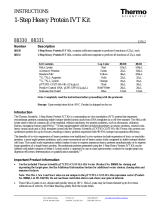Page is loading ...

INSTRUCTIONS
Pierce Biotechnology
PO Box 117
(815) 968-0747
www.thermoscientific.com/pierce
3747 N. Meridian Road
Rockford, lL 61105 USA
(815) 968-7316 fax
Number Description
26922
PITC (Edman’s Reagent), 10 × 1mL
Molecular Weight: 135.19
NCS
Formula: C
7
H
5
NS
Storage: Upon receipt store at room temperature.
Introduction
Thermo Scientific PITC (phenylisothiocyanate), also known as Edman’s Reagent, enables the sequential degradation of
amino acids in a polypeptide chain, yielding primary structural information.1,2 PITC reacts readily with amino acids at
alkaline pH. Precolumn derivatization results in phenylthiocarbamyl derivatives (PTC-amino acids) that can be separated and
quantified using reverse-phase HPLC.3-6 This method produces stable products with all amino acids, including proline. PITC
is volatile, making it possible to remove excess reagent in vacuo, thereby minimizing the possibility of reagent interference.
Detection of picomole quantities of the derivatives can be achieved using a UV detector at 254nm. PITC derivatization
followed by reverse-phase chromatography can be used for identification and quantitation of methylated, halogenated,
phosphorylated and sulfonated amino acids.6
Unlike Fmoc-chloride, PITC does not yield disubstituted tyrosine or histidine derivatives. PTC-amino acids demonstrate
improved stability at pH 5-7.5 as well as increased stability at room temperature over o-phthalaldehyde (OPA)-amino acid
adducts. Also, unlike OPA, PITC enables the direct analysis of secondary amino acids.
Example Protocol for Derivatizing Amino Acid Standard H
A. Additional Materials Required
• Amino Acid Standard H (Product No. 20088, 10 × 1mL, or Product No. 20089, 10mL)
• Coupling Solution: acetonitrile:pyridine:triethylamine:water (10:5:2:3)
• Analysis Solvent: 0.05M ammonium acetate or water:acetonitrile (7:2)
B. Method
1. Dry 10µL of Amino Acid Standard H in a small test tube. Dissolve dried standard in 100µL Coupling Solution.
Note: Make sure that all of the HCl is evaporated before derivatization.
2. Dry standard solution by rotary evaporation. Dissolve the residual amino acids again in 100µL Coupling Solution.
3. Add 5µL of PITC and allow reaction to proceed for 5 minutes at room temperature.
4. Evaporate sample to dryness by rotary evaporation under high vacuum.
5. Dissolve the resulting PTC-amino acids in 250µL of Analysis Solvent.
6. Analyze 1-10µL (100 to 1000pmol of each amino acid) by reverse-phase HPLC with UV detection at 254nm.
0863.2
26922
PITC (Edman’s Reagent)

Pierce Biotechnology
PO Box 117
(815) 968-0747
www.thermoscientific.com/pierce
3747 N. Meridian Road
Rockford, lL 61105 USA
(815) 968-7316 fax
2
Related Thermo Scientific Products
25104 Pyridine, 100g
51101 Acetonitrile, 1L
28901 Trifluoroacetic Acid, 500mL
25003 Heptafluorobutyric Acid, 100mL
Cited References
1. Edman, P. (1950). Preparation of phenylthiohydrantoins from natural amino acids. Acta Chem Scand 4:277-82.
2. Edman, P. and Begg, G. (1967). A protein seqenator. Eur J Biochem 1(1):80-91.
3. Heinrikson, R.L. and Meridith, S.C. (1984). Amino acid analysis by reverse-phase high-performance liquid chromatography: Precolumn derivatization
with phenylisothiocyanate. Anal Biochem 136:65-74.
4. Schoze, H. (1985). Determination of phenylthiocarbamyl amino acids by reverse-phase high-performance liquid chromatography. J Chromatogr
350:453-60.
5. Ebert, R.F. (1986). Amino acid analysis by HPLC: Optimized conditions for chromatography of phenylthiocarbamyl derivatives. Anal Biochem
154:431-5.
6. Cohen, S.A. and Strydom, D.J. (1988). Amino acid analysis utilizing phenyliosthiocyanate derivatives. Anal Biochem 174:1-16.
This product (“Product”) is warranted to operate or perform substantially in conformance with published Product specifications in effect at the time of sale,
as set forth in the Product documentation, specifications and/or accompanying package inserts (“Documentation”) and to be free from defects in material and
workmanship. Unless otherwise expressly authorized in writing, Products are supplied for research use only. No claim of suitability for use in applications
regulated by FDA is made. The warranty provided herein is valid only when used by properly trained individuals. Unless otherwise stated in the
Documentation, this warranty is limited to one year from date of shipment when the Product is subjected to normal, proper and intended usage. This
warranty does not extend to anyone other than the original purchaser of the Product (“Buyer”).
No other warranties, express or implied, are granted, including without limitation, implied warranties of merchantability, fitness for any particular
purpose, or non infringement. Buyer’s exclusive remedy for non-conforming Products during the warranty period is limited to replacement of or
refund for the non-conforming Product(s).
There is no obligation to replace Products as the result of (i) accident, disaster or event of force majeure, (ii) misuse, fault or negligence of or by Buyer, (iii)
use of the Products in a manner for which they were not designed, or (iv) improper storage and handling of the Products.
Current product instructions are available at www.thermoscientific.com/pierce. For a faxed copy, call 800-874-3723 or contact your local distributor.
© 2012 Thermo Fisher Scientific Inc. All rights reserved. Unless otherwise indicated, all trademarks are property of Thermo Fisher Scientific Inc. and its
subsidiaries. Printed in the USA.
/









